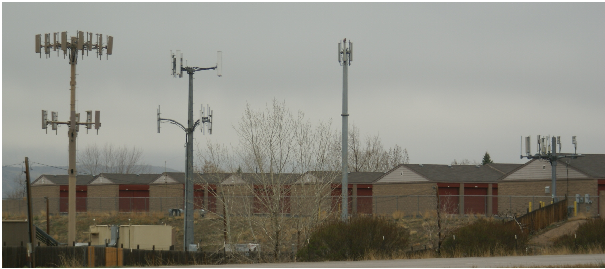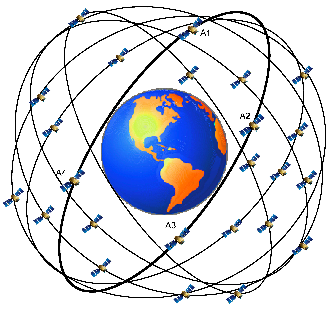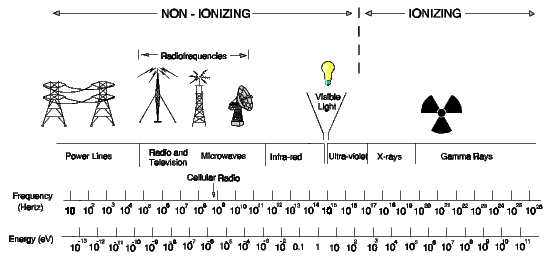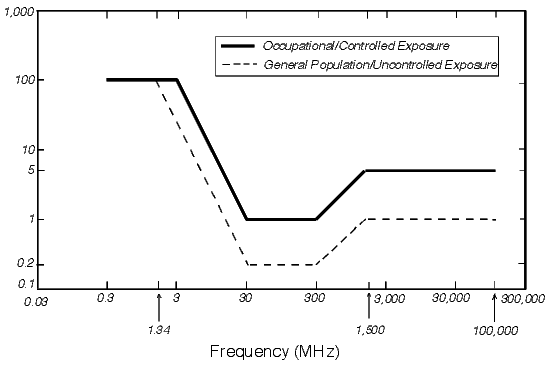

Copyright ©2019 Thomas Schwengler. A significantly updated and completed 2019 Edition is available.
We also review several ancillary yet important aspects of wireless systems: methods to synchronize cells, energy efficiency, and finally RF radiation levels and health concerns.
Wireless cellular networks require to build very many cell sites, both to provide good coverage, and to provide added capacity where needed.
Real estate is a major effort behind the choice of cell site placement and build-out. Several options are available to operators to gain access to tower or roof space. They use their own land and buildings (such as central offices) as cell sites, but also need to lease additional locations; in some cases public right-of-way or existing poles can be used.

Location choice is one of the most important decision: premium locations come at a price, sometimes more cells around a prime area (like a mall or airport) may be cheaper than on-site lease cost.
Height vs. number is also is an important design choice: higher macrocells cover more terrain but cost more; lower sites (minicells, microcells, nanocells, picocells) are cheaper, but more are needed (including backhaul). Now small cells are proposed that are cheap (like a LAN access points) and may even be connected to the network over a residential backhaul line for femtocells.
Many different types of towers are available to operators according to their needs and for different height, equipment weight, and wind conditions. Operators usually chose the cheapest possible among the following types of structures: large lattice towers, monopoles (galvanized steal, wood), or existing structures such as rooftops, water towers, utility poles (electricity, telephone).
High towers provide the most coverage, and typically allow for a large tower-top structure that can provide good horizontal diversity and achieve the best possible gains. For these tower, a fairly large enclosed area is usually placed nearby with large base station cabinets and power backup cabinets; remote locations may need several hours of power backup to account for technician travel time. Thicker coax cables are needed for higher towers since longer cables cause more cable loss and noise on the receiving end, and thicker cables reduce that cable loss. Tower-top low-noise amplifiers are an option (but with possible maintenance issues).
In recent years, the proliferation of towers has been such that some companies have specialized in actively buying and leasing these towers (and roof tops). These tower companies have grown, and the largest ones like Crown Castle International and American Tower own over 20,000 towers nationwide. Some of these tower companies (including the third largest, AT&T Towers, with over 10,000 towers) are subsidiaries of major wireless carriers, but will lease space even to a competitor.
The practice of co-locating on an existing tower started early in the cellular era as it has many advantages such as time saving in construction, zoning, local approvals, etc; also, dealing with a few tower companies can be an easier process than dealing with many different land owners. The main disadvantage is that these leases generally come at a higher price than private dealings with smaller landlords. It may seem surprising that wireless operators may be willing to lease tower space to their competitors, but often the reciprocal needs of competitors will lead to mutual agreements; also generating additional revenue is always tempting, especially from a competitor, besides, the competitor would eventually succeed in finding another spot in the vicinity, which would generate no co-location revenue.
Densely populated areas and cities usually no longer allow large towers, and smaller monopoles are the typical alternative, with smaller footprint, and smaller equipment. Co-locations are sometimes mandated by cities; European regulations even attempted to force antenna sharing between operators.

The design choices and processes involved in building all these cell sites in a time consistent with operators need is sometimes complex.
A site survey is usually necessary to examine practical details. Finally when a location is chosen, necessary local government hearings may be required, zoning requirements may be a restriction, and proper permits must be obtained.
Electrical and grounding are important considerations as well: the nature of cellular towers is to exceed the surrounding structures, and as such they are likely to be hit by lightning. Lightning rods with proper grounding are nearly always required.
Power must be brought to the tower for the wireless equipment, batteries are usually needed, and in some cases lighting is required for safety reasons. In many cases local power companies can bring metered power (for a fee and a recurring cost) but in some remote areas, power considerations can be an issue.
Concrete pads are also poured to place electronic and power cabinets. Fenced (and padlocked) enclosures are usually built when a large amount of equipment is placed at the site; in some cases a chain-link enclosure is enough, or for esthetic reasons a wall or a wooden privacy fence may be mandated by local government or land owner to hide the equipment cabinetry.
Voice backhaul was and is still often provided by wired T1 ordered from local telcos; although not always cheap, they are available nearly everywhere. Data backhaul initially (and in many cases still) have no choice than to rely on additional T1s. 3G and 4G data backhaul bring additional issues: throughput rates are increasing and cell sizes are decreasing; wireless carriers typically prefer highly reliable and scalable fiber backhaul, which is expensive to build-out.
While early cellular systems relied on very large umbrella cells, the recent tendency is to opt for more sites, but cheaper, and smaller. There are several reasons for that tendency: historically wireless networks were built to cover highways and commuter traffic, now more pedestrian and indoor coverage is required; recent wireless services focus on increased data rates which require higher modulation and lower link budgets, therefore smaller cells; and finally the cost of equipment is decreasing thus allowing many more sites (almost like LAN access points) rather than very large and expensive base stations that need to cover several square miles.
Wireless networks require a high capital investment upfront to create necessary coverage needed for customers. That large cost covers planning and building cell sites, leases, backhaul, and general operations.
General estimates of course vary with location, negotiation, and time, and rough orders of magnitudes can be outlined as follows:
Overall process for building a new tower may last 6 to 18 months.
It is also important not to underestimate recurring cost of operation: lease, backhaul, electricity, repair, maintenance are expenses that increase with the number of sites deployed.
Finally, other expenses add to the above for other business needs such as: a network operation center (NOC) to monitor alarms, schedule and dispatch repairs, load new software, schedule upgrades, etc. A fleet of engineers is also required for constant network optimization (RF, network, switching, signaling, and more).
All in all, designing a wireless network for a major area is of course difficult to estimate: a combination of large to small site are typically required, some for capacity in the core, some for good suburb and major axes coverage. Roll-out cost estimates vary greatly with times and locations. Frequency of operation also has a major impact (lower frequencies require fewer cells), and the amount of spectrum available has an impact as capacity considerations appear. Table 6.1 provide a typical estimate for a fairly large metropolitan area.
| One city roll-out | Number | Cost | Total | |
| (thousand $) | (million $) | |||
| Major sites | 300 | 200 | 60 | |
| Minor sites | 50 | 100 | 5 | |
| Addl. coverage | 40 | 200 | 8 | |
| Equipment | 390 | 60 | 23 | |
| Site prep and cabinet | 390 | 20 | 8 | |
| Wireless backhaul | 30% | 50 | 6 | |
| Total roll-out | 390 | 110 | ||
| Recurring cost | ||||
| Property leases | 9.6 | 3.7 | ||
| Wired backhaul | 10.8 | 4.2 | ||
| Maintenance, repair | 1 | |||
| Yearly Total | 9 | |||
The cost of rolling out networks on a large scale (nationwide) sometimes comes up in the press. With pending 4G upgrades, major carriers have announced anticipated costs of upgrading networks from to higher data standards: Sprint and Verizon announced in 2006 investments in excess of $1.5billion for EVDO upgrade to an existing network. Sprint-Nextel announced plans for $3billion in 4G/WiMAX rollout nationwide (not including backhaul), yet later modified that estimate to $2.5billion including backhaul (presumably due to the added participation of Clearwire).
700MHz deployments are also raising questions: coverage is easier and may lower the cost and time of achieving nationwide coverage; estimates vary from as low as $2billion for nationwide coverage to $12 billion to build out a nationwide 700 MHz system (not including the cost of the spectrum).
Most cellular standards including LTE require a very accurate cell sites timing reference within a network. Although any timing synchronization is allowed, Global Positioning System (GPS) is often used to provide that timing source. GPS is also used for mobile location determination, such as in handsets for emergency calls (911) or for location based services (see §11.5).
The GPS system is a wonderful tool and merits some attention and a few explanations. The GPS network was built for the department of defense and comprises of a constellation of (initially at least 24) satellites orbiting the earth (twice a day) at an 11,000 mile orbit. Satellites are grouped in trajectory planes (A to F), and are numbered within a plane (A1 to A4).

Each satellite has a very precise time source from cesium and rubidium atomic clocks and transmits a fast pseudo-random sequence; these sequences can be correlated to accurately determine a very accurate time offsets between receiver location and each satellite. This time delay corresponds to a distance to each satellite, which allows for position determination.
The legacy GPS signals are transmitted on two different frequencies known as the L1 (1575.42 MHz) and L2 (1227.6 MHz) frequencies. Each satellite uses a different ranging code, or spreading sequence. The ranging codes used by the satellites have very low cross-correlation properties between one-another. Each satellite uses two different ranging codes, the coarse acquisition (C/A) code and the precision (P(Y)) code. The C/A code is a short (1023 bits) code modulated on to the L1 frequency, that is a 1.023 Mcps pseudo-random sequence repeated every millisecond. The P(Y) is a longer code (6.1871 ⋅ 1012 bits) that is modulated onto both L1 and L2 frequencies, it is a 10.23 Mcps sequence used to improve accuracy. Signal strength reaching the earth are generally in the -127 to -130 dBm range. (For more details see www.gps.gov.)
Simple geometric considerations show that four spheres are needed for a location determination; three spheres determine two possible locations, which is usually sufficient (the fourth sphere being the surface of the earth), or the speed of satellites involved might mean that one of the two locations is moving at extra-terrestrial speeds and is unlikely to be the receiver of interest. Any additional satellite signal can be used to further refine positioning as well as providing an accurate timing source.
In practicality the three or more spheres do not exactly intersect and some distance uncertainties remain: the actual sequence correlation process is imprecise to about 10ns, which is an uncertainty of 3m. Ionospheric and tropospheric effects tend to change the permitivity of the atmosphere, which impact the speed of transmission, and cause variations; these variations depend on trajectories, and if a satellite is for instance near zenith or near horizon. These variations are typically slow though and can somewhat be mitigated. Similarly some multipath distortion due to nearby terrestrial structures may occur, these can vary very fast and may need other mitigation methods. Satellite clock errors, orbit adjustment, or temporary unavailability are also causes for errors. Even relativistic terms due to satellite speeds cause onboard clocks to slowly drift. These errors may add up to several meters, and simple GPS measurements have an accuracy of 30 to 100m depending on environment and number of satellites.
Many of these errors can be attenuated by differential GPS (DGPS) in which two nearby stations measure GPS location and time; since these are relatively close (say within 100 miles), the large atmospheric variations are very similar for both stations. Now equip one station as a fixed known location and an accurate atomic clock, and the atmospheric errors can be estimated and removed to improve the second station measurements. DGPS can reach sub 10m position accuracy.
The question of health risks associated with wireless devices comes up regularly in the press. The significant increase of cellular phone use is a concern to the public, and to regulators. When requesting a permit to build a new tower, operators have to answer questions from city council members or elected officials on health risks and concerns.
Health hazards caused by radiations vary greatly with the frequencies of radiations: ionizing radiations above UV rays (including X-rays and gamma rays) have severe physiological effects. Radiations below 300 GHz are our concerns here; they are referred to as non-ionizing since their energy levels are below 100’s eV and therefore not sufficient to impact valence liaisons in molecules and atoms.
Copyright ©2018 Thomas Schwengler.

They may still be somewhat controversial since the general opinion is concerned about the increasing use of radio devices; clear evidence of health hazards are less obvious, but nonetheless, studies continue to consider carcinogenic, reproductive, and neurological effects. Health risks associated with high level radiations have long been a concern but have failed to provide convincing proof. The effects of power lines on the central nervous system have been of most concern as one study cites an apparent increased risk of leukemia in children by exposure to power magnetic fields (from 50-60 Hz power lines) in excess of 0.4 μT. A more recent report finds the epidemiological evidence not strong enough to justify the conclusion [104]. Studies have focused on workers exposed to static magnetic fields up to a few millitesla with no signs of elevated cancer risks; other studies found no association between the risk of brain or lymphatic cancer in either static or power frequencies (50-60 Hz), but the number of cases studied were small, and more studies are required.
In the US, the Occupational Safety and Health Administration (OSHA)1 publishes study results and guidelines for safety. Other associations monitor new studies, such as the IEEE, or federal interagency work groups. Internationally, guidelines have been issued by the International Commission on Non-Ionizing Radiation Protection (ICNIRP) in a 1998 report. Other international bodies such as the Independent Expert Group on Mobile Phones (IEGMP) have also published reports and recommendations on mobile phones and health.
A difficulty in the development of guidelines for exposure to radiations lies in the fact that health impacts may be difficult to track, and that controversies sometimes arise from the source of funding of some studies (with potential conflicts of interests).
We’ll study two major concerns related to wireless systems: 1) the presence of towers and high power transmitters on a property, and 2) the effects of handsets on the human body.
RF energy absorbed by the body elevate its temperature and has major effects on the body: as the heat is distributed throughout the body by blood circulation, it causes whole body heating, which has the following impacts:
Studies show that an elevation of 1∘C start to have effects. Many of these effects are temporary (with exception of prenatal development), but nonetheless may be very dangerous and increase health risks or accidents. In all cases, the only remedy is simply to move away from the radiations.
Some localized heating may be cause for concern as well, and occur generally when tissue temperature exceed 42∘C for more than about an hour:
The eyes and the testes are known to be particularly vulnerable to localized heating by RF energy because of the relative lack of available blood flow to dissipate excessive heat; effects are usually temporary except in the case of the eyes where irreversible damage (cataract) may occur.
Base stations may cause concerns because of the multiple Watt power levels they radiate and the number of large antennas they have. Yet studies and reports all seem to conclude that exposure from living near a cellular cell site are very low and unlikely to pose any health risk. Of course, the widespread presence of cell sites is still a fairly recent situation, especially with the more recent trend to small cells, so more long-term studies are required. Calculations of base stations exposures is detailed further in §6.3.4.
The main health risk associated with the use of cellular handsets might be that of increased inattention and resulting accidents on the road. New York first passed laws banning cell phones while driving in 2001 (followed by New Jersey, Connecticut, Utah, and Washington, D.C.). California passed a law in July 2008 to limit cell phone usage to experienced drivers and to the use of hands-free kits. That topic has been the subject of numerous studies on: cause for inattention while driving, use of hand-free kits, seriousness and frequency of accidents, etc. Some interesting findings:2
(The last few points might argue that accidents seem to be caused more by driver inattention due to the phone conversation, rather than by the fact that hands are busy with a handset.)
Other serious risks have been investigated on the danger of using cellular phones ranging from: impact on pacemakers, cancer causing handsets, etc. It is difficult to distinguish the part of anecdotal data, hearsay, or fibs from actual facts. Studies are rare, and sometimes funded by parties feared not to be impartial.
Early handsets and car phones used fairly high power levels (as high as 3W), and may have caused health concerns. (Early wireless industry workers have even alleged that early trial prototypes caused severe health damage such as cancerous brain tumors.) But current handsets seem to offer no such concerns: transmitted powers are usually below 200mW and never exceed dangerous power density levels.
The high peak-to-average ratios associated with modern digital techniques like GSM and CDMA have caused concerns as well, but the problem is more difficult to pose and less obvious to study. Studies have considered various physiological effects: cognitive effects, pulse modulation effects on the nervous system, mutation, cancer risks (brain tumors, malignant melanoma in eye or skin), effect on pregnancies, fatigue, headaches, warmth, stress, nervousness, and even mortality rate. Evidences from hundreds of studies of populations near major broadcast facilities, cell site towers, analog or digital cell phone usage, even cordless phone usage have been examined and reported. Most non thermal effects remain inconclusive so far for these types of low level RF exposures [104].
Most studies conclude that the effect of temperature elevation on the human body is the main effect from RF radiations, but also agree that further research and studies are required, especially on longer term data. Recent research has suggested that non-thermal effects do occur. The phenomenon of RF “hearing” has been reported and verified: the human auditory system responds to RF energy pulses (in the 2 MHz to 10 GHz range), converting it in or around the cochlea to acoustic energy, similar to a buzz, click, or hiss. Finally, alterations in animal behavior patterns following RF and microwave radiation exposure have been observed.
In conclusion: current evidences are derived from fairly recent usage data, and with ever increasing use of wireless devices, including at younger ages, longer term studies are required. Until convincing data are produced, the issue is likely to gain more press attention in the next few years, and even become a politicized debate. For example: in the European community, countries such as France, the U.K., Germany have issued advisories to limit exposure to cell phone radiations. The French government has considered a cell-phone ban for children, pending more studies on long term effects on the developing body. And in July 2008, a research group in the US issued an advisory of caution including particularly strong advice for protecting children from cell phone radio waves, due to “children’s small size, rapidly growing bodies and brains, and potential for long-term exposure”.
The bottom line is that these questions are unlikely to be settled for a few years, until new convincing research results are produced. For now, the industry remains in a state where regular review of current guidelines are still necessary.
The FCC derives guidelines for human exposure to RF levels; these guidelines are derived from the recommendations of two expert organizations, the National Council on Radiation Protection and Measurements (NCRP) and the Institute of Electrical and Electronics Engineers (IEEE), and are based on the many studies mentioned above [107]. Many other expert bodies exist that generate similar guidelines for the EU and other parts of the world; the World Health Organization (WHO) is usually involved in a harmonization effort for every country to agree to similar guidelines.
In the case of RF (non ionizing) radiations, power density of radiations impinging the human body is used to measure the level of exposure. The quantity of RF energy actually absorbed by the body is called the Specific Absorption Rate (SAR); the SAR is usually expressed in units of watts per kilogram (W/kg).

| Occupational/Controlled | General/Uncontrolled | |
| exposure | exposure | |
| (100 kHz - 6 GHz) | (100 kHz - 6 GHz) | |
| Whole-body | <0.4 W/kg | <0.08 W/kg |
| Partial-body | ≤8 W/kg | ≤1.6 W/kg |
| Frequency | Electric Field | Magnetic Field | Power Density | Averaging |
| Range | Strength (E) | Strength (H) | Time | |
| (MHz) | (V/m) | (A/m) | (mW/cm2) | (minutes) |
| 0.3-3.0 | 614 | 1.63 | (100)* | 6 |
| 3.0-30 | 1842/f | 4.89/f | (900/f2)* | 6 |
| 30-300 | 61.4 | 0.163 | 1.0 | 6 |
| 300-1500 | – | – | f/300 | 6 |
| 1500-100,000 | – | – | 5 | 6 |
(B) Limits for General Population/Uncontrolled Exposure
| Frequency | Electric Field | Magnetic Field | Power Density | Averaging |
| Range | Strength (E) | Strength (H) | Time | |
| (MHz) | (V/m) | (A/m) | (mW/cm2) | (minutes) |
| 0.3-1.34 | 614 | 1.63 | (100)* | 30 |
| 1.34-30 | 824/f | 2.19/f | (180/f2)* | 30 |
| 30-300 | 27.5 | 0.073 | 0.2 | 30 |
| 300-1500 | – | – | f/1500 | 30 |
| 1500-100,000 | – | – | 1.0 | 30 |
f = frequency in MHz.
* = Plane-wave equivalent or far-field equivalent power density.
NOTE 1: Occupational/controlled limits apply in situations in which persons are exposed as a consequence of their employment provided those persons are fully aware of the potential for exposure and can exercise control over their exposure. Limits for occupational/controlled exposure also apply in situations when an individual is transient through a location where occupational/controlled limits apply provided he or she is made aware of the potential for exposure.
NOTE 2: General population/uncontrolled exposures apply in situations in which the general public may be exposed, or in which persons that are exposed as a consequence of their employment may not be fully aware of the potential for exposure or can not exercise control over their exposure.
Since 1996, FCC guidelines are based on the estimate that potentially harmful biological effects can occur at SAR level of 4 W/kg as averaged over the whole-body (as identified by NCRP, IEEE, and ICNIRP reports). Safety guidelines are derived from these thresholds; and additional safety factors have been incorporated to consider partial-body exposure. The FCC also differentiates between occupational exposure in closed environment, and more general population exposure, which tend to occur in more open conditions.
In general, FCC guidelines are set in terms of Maximum Permissible Exposure (MPE) limits for frequencies from 300 kHz to 100 GHz, as shown in Table 6.3 and Figure 6.5 [105] [106]. The reason for differentiating with frequencies is that higher frequencies have fairly low penetration depth, whereas lower frequencies penetrate the body and may heat internal body tissues. For frequencies Above 10 GHz (3 cm wavelength) heating occurs mainly on the skin, which acts as a shield and (other than in the eyes) may safely sustain fairly high radiation levels. From 10 GHz to 3 GHz (3 cm to 10 cm wavelength) the penetration and heating is deeper, and from 1.2 GHz to 150 MHz (25 cm to 200 cm) penetration and absorption are sufficient to cause heating of internal body tissues, and hence require the lowest exposures limits.
Furthermore, a time average is considered over which the levels of exposure should be averaged; in that calculation levels of exposures may be exceeded for short time periods as long as the average over the specified time does not exceed guideline levels: if exposure levels exceed the prescribed limit by a small percentage, simply reduce the amount of time exposure by that percentage.
Recently (2012) a Government Accountability Office report recommended the FCC reassess the current official guidelines and update its safety standards; so the guidelines presented here, valid as of publication date, are subject to change.
The general approach to calculate permissible exposure of any device is to start with estimating Maximum Permissible Exposure (MPE) limits shown in Table 6.3 and Figure 6.5 [105] [106]. These calculations however may vary greatly with the specifics of the situation.
In the far field In many cases, calculations are needed in the far field, which is approximately at a distance greater than the Fraunhofer distance 2D2∕λ. Power density in the far field is simply estimated by [106]:
 | (6.1) |
where P is the power input to the antenna (in W or mW, not dBm), G in the linear antenna gain relative to isotropic radiator (linear gain is not in dBi, G = 10dBi∕10), and d is the distance to the antenna. As one evaluates exposure level near a base station, the change of antenna gains may be significant and ignoring them (and using the maximum antenna gain) can lead to overestimation of exposure levels.
Reflection in the far field In many cases, multiple rays reach the location of interest for MPE (at least two with reflection off the ground as in §3.3). In that case it is important that electric fields can add coherently, and a worst-case prediction for two rays would be to quadruple exposure levels of equation (6.1): S
2-ray=EIRP∕πd2. Ground and wall reflections can be significant in confined indoors environments, where better reflection estimates are useful (see for instance §3.3.3).
Multiple contributions in the far field When multiple antennas are co-located on a pole or several nearby structures in an antenna farm, each contribution must be calculated individually. Each contribution can be prorated to a percentage of the MPE, and the sum of all contributions should not exceed 100%.
For example: say a wireless carrier colocates on a tower two antennas for service at 600MHz and at PCS (1900MHz). Assume the first antenna causes actual measured limits at one test location of 200μW/cm2 (i.e. 50% of the allowed MPE from table 6.3 for general population exposure). Assume that the PCS measurement shows 400μW/cm2 (corresponding to 40% of allowed occupational MPE at that frequency). The combined exposure is then estimated to be 90% of MPE level, therefore considered safe for the general population as it is below 100% of official MPE guidelines.
Near an antenna Power density near the surface of an aperture antenna (such as Cassegrain type antennas with parabolic reflectors used for microwave links) can be approximated by S = 4P∕Ap, where P is the power fed to the antenna, and A is the physical aperture antenna area. (Other estimates exist [106] for various antenna types and ranges from close to the antenna to the far-field.)
Hand-held devices Hand-held devices held close to the body (say within 20cm) need some specific modeling; MPE calculations usually do not apply here, and exposure limits relate instead to the partial body specific absorption rate (SAR). Models or calculations typically estimate SAR levels and how they compare to table 6.2.
Copyright ©2019 Thomas Schwengler. A significantly updated and completed 2019 Edition is available.